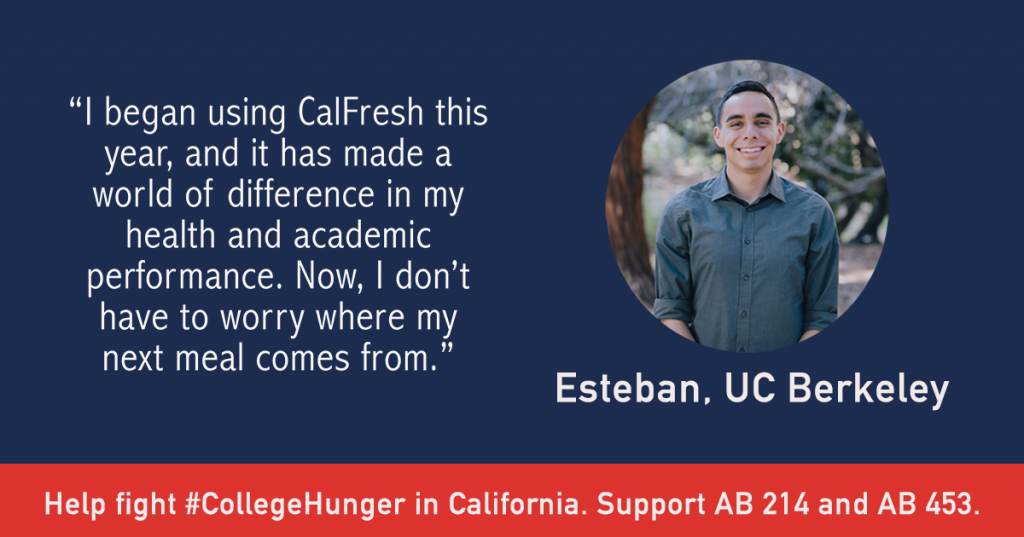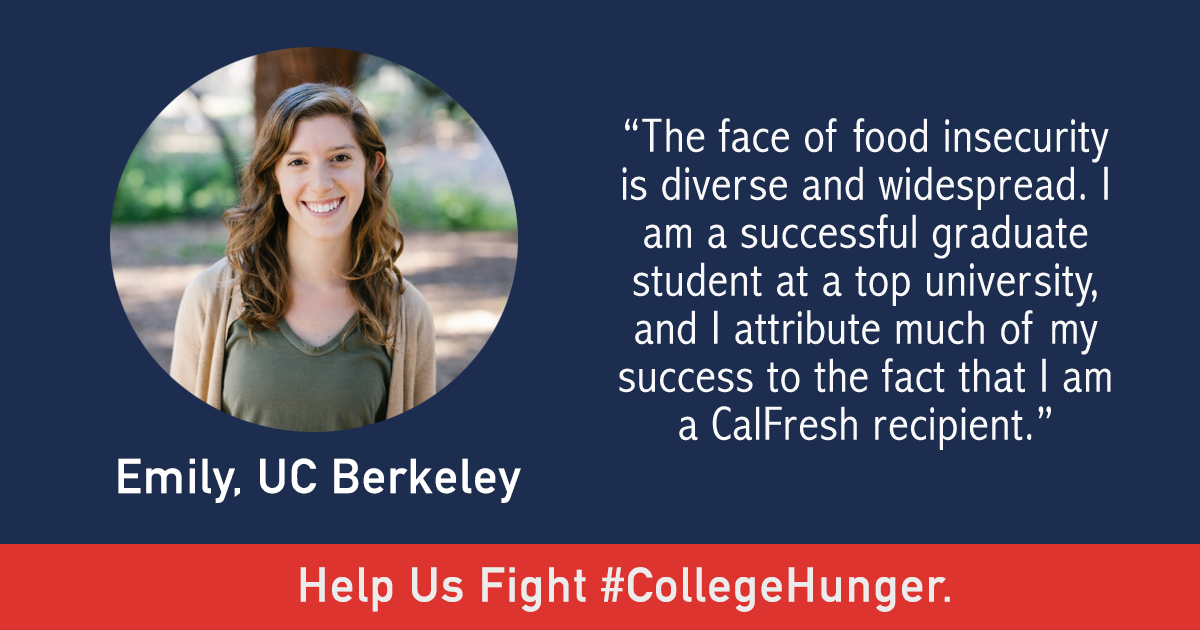So many of us have heard the myth of the struggling college student – from movies to well-meaning pep talks, pulling all nighters and subsisting on cold pizza are often portrayed as part of the classic college experience. It makes you “tough” or it means you’re “working hard.”
But for too many students, that myth is a crippling reality. Thousands of college students experience food insecurity every day, a condition characterized by disrupted eating patterns and reduced quality and quantity diets. Often times this experience goes unnoticed, as schools depend on students to self-report their hunger.
But we’re learning more about this issue. In California, schools have begun to get a picture of hunger on their campuses with the help of data gathered by the Wisconsin HOPE Lab, and system specific surveys. The findings – that 68% of community college students, 24% of California State University students, and 42% of University of California students, experience food insecurity – have galvanized state legislators to act. Below, two current University of California students, Emily and Esteban, share why they’re supporting two bills currently in the California Assembly – AB214 and AB453 – to address this issue.
Esteban, UC Berkeley

Growing up, I was told that working hard and going to college would lead to a good career, improve my life, and allow me to help others in my community. That was the plan. So when I received my acceptance letter from University of California, Berkeley, I was thrilled to get started. As a first-generation college student, I quickly learned that being in college was more challenging than just getting good grades. Beyond attending classes, studying, and becoming used to a new environment, economic insecurity sometimes impacted my ability to secure even the most basic of necessities. The high cost of food, coupled with increasing rent in the Bay Area and costly textbooks caused me, and many students like me, to experience food insecurity at some point during our education.
During my sophomore year, I found myself down to only one full meal a day; I drank a smoothie in the morning and had dinner in the afternoons. This had a negative impact on my health and led to poor performance in my academics and at work. However, all this changed when I was introduced to CalFresh, California’s food assistance program.
I began using CalFresh, California’s federally funded food and nutrition assistance program, in February 2017, and it has made a world of difference in my health and academic performance. I don’t have to worry where my next meal comes from. I can now walk into a grocery store and purchase the food I need to sustain myself consistently. I eat three meals a day, which is a huge step up from the makeshift meals I struggled through previously. I can finally focus on my education, and have introduced CalFresh to multiple friends in similar situations, and they too have experienced the benefits of this program.
My experience with food insecurity and spreading information to my immediate friend group inspired me to advocate for other students that may be in the same position but who don’t know the resources available to them. I joined the Basic Needs Security Committee at UC Berkeley, a student group that combats hunger, malnourishment, and homelessness on campus. Currently, 39 percent of undergraduate and 23 percent of graduate students on my campus are food insecure. The use of our campus food pantry has grown exponentially in the past months, thanks to increased awareness of these resources and our new, convenient on-campus location. We had 1,429 visits in February, demonstrating the need for such supplemental programs.
Although CalFresh has tremendous potential to help struggling students, there are imperfections in the program. Oftentimes, high-need students face challenges getting approved and enrolled, which prolongs their lack of access to food security. I support legislation that helps to remove those barriers, and creates a wider range of access to students who sacrifice nutrition for education. Two bills currently in the California State Assembly, AB 214 and AB 453, introduced in this legislative session, provide critical foundations for fostering a more food secure community on California’s college campuses. I for one, am thrilled to now be able to focus on my education and not worry about how or when I’ll eat next.
Emily, UC Berkeley

Food insecurity impacts a striking number of students on college campuses, particularly in California. In the University of California system alone, almost half – 48 percent – of all undergraduate students and a quarter of all graduate students are food insecure. This means that one in every two undergraduate student eats a reduced quality and/or quantity diet, mostly due to an inability to purchase foods. As a public health graduate student and a member of the UC Berkeley Basic Needs Security Committee, I believe that access to food is a fundamental human right. When this necessity is threatened or revoked, we cannot expect students to excel academically – let alone graduate, balance a full course load, work, pay rent, and be successful when they enter the workforce.
There are many efforts on college campuses to address food insecurity, including food pantries and meal point donations. However, these don’t address the underlying root causes of food insecurity, such as the inability to select and purchase foods due to affordability. CalFresh, California’s food assistance program, is by far the most impactful way of addressing food insecurity. Through my work I have spoken with a number of students, and analyzed surveys of many more, to understand their experiences with food insecurity. Those who receive CalFresh speak about its ability to lift them out of food insecurity, allowing them to flourish in school and maintain physical and mental health. Those who do not receive CalFresh experience barriers to signing up, including complex applications with documentation requirements that the average students cannot meet.
I recently spoke with one student who exclusively shops for food at a dollar store. When we first met he only had a package of granola bars for the day. He has experienced homelessness as well, and is struggling to make ends meet. Even though he is beginning the process of applying for CalFresh, the complicated application process is preventing him from immediate food security. A more accessible application and an option to buy food with CalFresh dollars on campus would be hugely helpful for him, and for the other tens of thousands of students who are food insecure.
The face of food insecurity is diverse and widespread. I am a successful graduate student at a top university, and I attribute much of my success to the fact that I am a CalFresh recipient. Without the extra $200 to spend on food each month, I would certainly struggle to pay my rent while juggling a full course load, doing my research, and working two jobs.
Students who are food insecure are negatively impacted physically, emotionally, and academically. There is no question in my mind that continuing to find ways to simplify CalFresh access is a necessary step toward supporting our students, and I am proud to support our legislature’s efforts this year to do just that.
